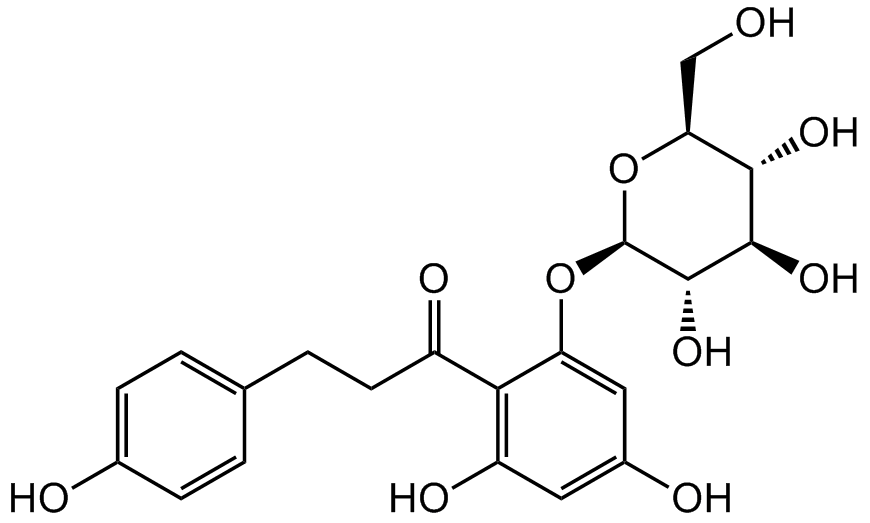Phloridzin
Product Code:
CDX-P0263
CDX-P0263
Host Type:
Plant
Plant
Regulatory Status:
RUO
RUO
Shipping:
AMBIENT
AMBIENT
Storage:
Short Term: +20°C, Long Term: -20°C
Short Term: +20°C, Long Term: -20°C
No additional charges, what you see is what you pay! *
| Code | Size | Price |
|---|
| CDX-P0263-M250 | 250 mg | £48.00 |
Quantity:
| CDX-P0263-G001 | 1 g | £72.00 |
Quantity:
Prices exclude any Taxes / VAT
Stay in control of your spending. These prices have no additional charges, not even shipping!
* Rare exceptions are clearly labelled (only 0.14% of items!).
* Rare exceptions are clearly labelled (only 0.14% of items!).
Multibuy discounts available! Contact us to find what you can save.
This product comes from: Switzerland.
Typical lead time: 7-10 working days.
Contact us for more accurate information.
Typical lead time: 7-10 working days.
Contact us for more accurate information.
- Further Information
- Documents
- References
- Show All
Further Information
Alternate Names/Synonyms:
Floridzin; Phloretin 2'-glucoside; Phloridzosid; Phlorizin; NSC 2833
Appearance:
Light yellow to off-white powder.
CAS:
60-81-1
EClass:
32160000
Form (Short):
liquid
Handling Advice:
Protect from light and moisture.
InChi:
InChI=1S/C21H24O10/c22-9-16-18(27)19(28)20(29)21(31-16)30-15-8-12(24)7-14(26)17(15)13(25)6-3-10-1-4-11(23)5-2-10/h1-2,4-5,7-8,16,18-24,26-29H,3,6,9H2/t16-,18-,19+,20-,21-/m0/s1
InChiKey:
IOUVKUPGCMBWBT-RQUKQETFSA-N
Long Description:
Chemical. CAS: 60-81-1. Formula: C21H24O10. MW: 436.413. Phlorizin is a natural product, first isolated from the bark of apple trees, that reduces plasma glucose levels by blocking renal and intestinal glucose absorption through inhibition of SGLT1 and SGLT2. It competitively inhibits (competes with D-glucose) the initial rate of alpha-methyl-D-glucopyranoside (alpha-MDG) uptake in the nM range. Phlorizin has been shown to enhance insulin sensitivity and to have antioxidant properties. Sodium-glucose cotransporter 1 (SGLT1) is a high affinity, low capacity transporter abundant in the small intestine, with some expression in the kidney as well. SGLT2 is a low affinity, high capacity transporter in the kidney that accounts for approximately 90% of glucose reabsorption into the blood stream. Selective inhibition of SGLT2 is a potential strategy for reducing plasma glucose levels as a treatment for diabetes.
MDL:
MFCD00006591
Molecular Formula:
C21H24O10
Molecular Weight:
436.413
Package Type:
Vial
Product Description:
Phlorizin is a natural product, first isolated from the bark of apple trees, that reduces plasma glucose levels by blocking renal and intestinal glucose absorption through inhibition of SGLT1 and SGLT2. It competitively inhibits (competes with D-glucose) the initial rate of alpha-methyl-D-glucopyranoside (alpha-MDG) uptake in the nM range. Phlorizin has been shown to enhance insulin sensitivity and to have antioxidant properties. Sodium-glucose cotransporter 1 (SGLT1) is a high affinity, low capacity transporter abundant in the small intestine, with some expression in the kidney as well. SGLT2 is a low affinity, high capacity transporter in the kidney that accounts for approximately 90% of glucose reabsorption into the blood stream. Selective inhibition of SGLT2 is a potential strategy for reducing plasma glucose levels as a treatment for diabetes.
Purity:
>98% (HPLC)
SMILES:
OC1=CC=C(CCC(C2=C(O)C=C(O)C=C2O[C@@H]3[C@@H](O)[C@H](O)[C@@H](O)[C@H](CO)O3)=O)C=C1
Solubility Chemicals:
Soluble in DMSO (20mg/ml), DMF (20mg/ml) or ethanol (5mg/ml).
Source / Host:
Plant
Transportation:
Non-hazardous
UNSPSC Category:
Natural Products/Extracts
UNSPSC Number:
12352200
Use & Stability:
Stable for at least 2 years after receipt when stored at -20°C.
Documents
References
(1) G. Toggenburger, et al.; Biochim. Biophys. Acta 688, 557 (1982) | (2) N. Oulianova, et al.; J. Membr. Biol. 179, 223 (2001) | (3) K.P. Briski & E.S. Marshall; Neurochem. Res. 26, 783 (2001) | (4) R.J. McCrimmon, et al.; Am. J. Physiol. Endocrinol. Metab. 283, E1076 (2002) | (5) J.R.L. Ehrenkranz, et al.; 21, 31 (2005) (Review) | (6) J.R. White; Clin. Diabet. 28, 5 (2010) | (7) C.S. Hummel, et al.; Am. J. Phys. cell Phys. 300, C14 (2011) | (8) C.S. Hummel, et al.; Am. J. Phys. cell Phys. 302, C373 (2012) | (9) T. Nagata, et al.; Am. J. Physiol. Renal. Physiol. 306, F1520 (2014) | (10) Y. Katsuda, et al.; Exp. Anim. 64, 161 (2015) | (11) M. Raja & R.K. Kinne; Biochimie 115, 187 (2015) | (12) X. Mei, et al.; J. Agric. Food Chem. 64, 7502 (2016) | (13) R.A. Mendes, et al.; J. Mol. Model 24, 101 (2018)



